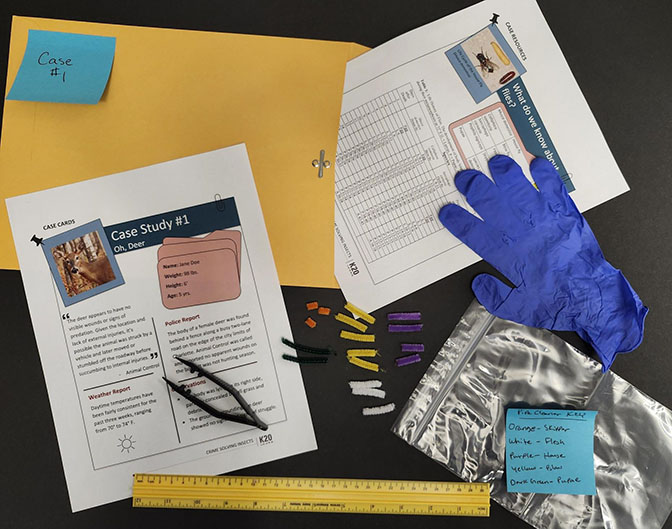Summary
In this lesson, students delve into the fascinating field of forensic entomology by engaging in hands-on and reflective activities designed to spark curiosity, deepen understanding, and apply critical thinking skills. After reviewing the life cycle of flies, students will act as forensic investigators and work through authentic case studies. Students will gain a deeper understanding of forensic entomology, its processes, and its real-world applications in solving crimes.
Essential Question(s)
How do insects aid in forensic investigations?
Snapshot
Engage
Students review and activate prior knowledge about Forensic Entomology using an ABC Graffiti poster.
Explore
Students recall the life cycle of flies with a Card Sort.
Explain
Students review key concepts, complete guided notes, and apply newly learned skills to solve a model case study.
Extend
Students solve forensic case studies by collecting, analyzing, and interpreting data and evidence.
Extend 2 (Optional)
Students have the option to watch an additional ICAP highlighting another career path related to forensic entomology.
Evaluate
Students synthesize information learned and complete a reflection activity.
Materials
Lesson Slides (attached)
ABC Graffiti handout (attached; one per group)
Life Cycle Map handout (attached; one per group, See “Preparing the Lesson”)
Life Cycle Cards handout (attached; one set per group, See “Preparing the Lesson”)
Forensic Entomologist Guided Notes handout (attached; one per student)
Reflect & Discuss handout (attached; one per student)
Detective Notes handout (attached; one per student)
Designing the Case Folders handout (attached; teacher copy)
Case Cards handout (attached; See Designing the Case Folders)
Case Resources handout (attached; See Designing the Case Folders)
Pen/Pencil
Markers (a different color per group)
Pipe cleaners (See TN below)
Ruler (one per group)
Folders
Preparing the Lesson
30 Minute(s)
Explore - Card Sort Activity
Print Life Cycle Map and Life Cycle Cards (one per group). Each page has two sets of cards; each group needs only one set.
Cut pipe cleaners to 16mm, 25mm, 31mm, and 34mm.
Laminate Map and Cards for durability (optional).
Store each set of Cards + cut pipe cleaners in a plastic bag per group.
Extend - Case Stations Activity
Create the “Case Folders” by using the Designing the Case Folders handout as a reference. Make multiple copies of “Case 1,” including one for yourself. Then, place 1-2 copies of each of the other case folders at three different stations around the room for students to rotate through.

Engage
15 Minute(s)
Move to slide 2 and introduce students to the ABC Graffiti instructional strategy. Divide students into small groups and pass out one marker and one ABC Graffiti poster per group. Explain to students that their group will fill in as many letters according to the prompt as they can before time is up. Then, they will take their markers and move as a group to the next poster and continue where the last group left off within the time allotted. Use slides 3-5 to facilitate each round. Afterwards, ask for volunteers to share their responses.
Transition through slides 6-8 to review the lesson title, essential question, and lesson objectives.
Explore
25 Minute(s)
Place students into small groups and pass out the Life Cycle Map handout, the sets of Life Cycle Cards handout with the cut pipe cleaners, and a ruler to each group. Explain that students will be doing a modified Card Sort activity to review the bug life cycle. Move to slide 9 and ask student groups to identify the life cycle stages of using the “Round 1” cards. Start the timer and let students work. It’s okay if they don’t get the correct answers at this point in the lesson.
Once the timer goes off, pass out the Forensic Entomologist Guided Notes handout to every student and move to slide 10. Review the answers to the Life Cycle Map and clear up any misconceptions.
Display slide 11. Have students retrieve the pipe cleaners from their bags. Instruct students to measure and place the pipe cleaners (which represent a fly at each stage) on the space for “Size” and start the timer. Remind students that not all spaces will be filled. After the timer goes off, ask for volunteers to make some guesses as to the size of some of the stages.
Go to slide 12. Have students take out the last set of cards from their bag. Using the information gathered so far, they should infer the duration of each fly stage by placing the “Round 3” cards in the “Time” space. Then, start the timer. After the timer goes off, transition through slides 13-15 to review the answers to “Rounds 2 and 3” while students continue filling in the Guided Notes handout. Encourage them to rearrange their maps as needed. When explaining how adult flies lay their eggs on a carcass on slide 13, be sure to highlight how these openings are the easiest point of entry. This will be important later for the case studies they attempt.
Explain
60 Minute(s)
Transition through slides 16-17. Review what a forensic entomologist does. Students should continue to fill in their Forensic Entomologist Guided Notes handout.
Move to slide 18 and introduce the I Notice I Wonder strategy. Explain to students that they should go to the chart on their handout and add their reflections while watching the following video clip. Transition to slide 19 and play the Forensic Entomology video clip.
Display slide 21 and explain how forensic entomologists use insects as evidence. If you are starting on a new day, remind students to get out their Guided Notes handout and continue filling it in. Move to slide 22 and invite students to draw visuals of how they understand the stages of body decomposition using the Cognitive Comics instructional strategy. Explain that as they go through the next few slides reviewing each stage, they should use the space provided on their handout (“Stages of Decomposition”) to depict the content visually. Encourage students to use an animal or human body as the main image. Once students are prepared, transition through the stages of decomposition with slides 23-26 in as much detail as needed. When reviewing the image of the fly cycle, it goes as follows, clockwise from left to right eggs, larva, pupa, adult. After reviewing the content on slide 26, ask for any student volunteers to share their comic strips.
Transition through slides 27-29 to review which insects appear at each decomposition stage. Emphasize how their presence or absence helps forensic scientists determine PMI (post-mortem interval). For example, when scientists see the hide beetle, they know that the flies have already come and gone and that the body is in a late stage of decomposition.
Display slide 30 and explain to students that now that they have reviewed how insects are used in forensic entomology, they will see how someone in the field applies this knowledge. Show the ICAP video: Crime Solving Insects with Michael Chism.
Michael Chism discusses his job, which uses dermestid beetles to clean skulls and carcasses and explains how he was led into this career. After they view the video, move to slide 31 and review what educational paths students can take to apply the skills they are learning about forensic entomology to the career they just learned about.
Divide students into small groups and distribute “Case 1” folders (see the Designing the Case Folders handout). Explain that you will model “Case 1” while reviewing forensic entomology. Give each student a Detective Notes handout. Display slide 32 and allow students time to review the materials. Then, invite students to place everything to the side or center of their group making sure to keep the bag of “evidence” still sealed closed. Next, lead a discussion using slide questions. Instruct students to take notes on the Forensic Guided Entomologist Notes handout.
Transition through slides 33-34 and review insect succession. On slide 33, the table depicts which insects appear at which state of the body decomposition. Highlight that blow flies are the first to arrive, as this is relevant to the case studies. Next, move to slide 35 and have students find their Case Resources handout from the folder. Facilitate a class discussion using the questions on the slide.
Transition through slides 36-37 to review other factors that impact a PMI (postmortem index). Again, remind students to continue to take notes on the Guided Notes handout as you work through the slides. When reviewing slide 37, remind students that not only temperature but also the presence of drugs will affect the development of fly larvae and increase or decrease the estimated PMI. Move to slide 38 and have students read through the Case Card for “Case 1.” Have them measure their evidence. Allow students time to work through the questions with their group before asking for volunteers to answer the questions. Answer questions, ask clarifying questions/evidence to support their answers, and then clear up any misconceptions. Then move to slide 39 and go over the answers.
Have students return all materials to their Case Folder and turn them in before moving to the Extend.
Extend
60 Minute(s)
Place students in small groups and display slide 40. Explain that they will be assigned to their first station/case and that they are only to rotate to the next station when instructed to. If needed, unhide slide 41 and provide more explicit reminders of how to use the Case Resources effectively. Move to slide 42 and instruct students to use all their resources to solve the cases as the class did with “Case 1.” Start the 10-minute timer on slide 42 and announce when it’s time for students to move to the next station. Keep restarting the timer after each rotation.
When all groups have solved each case, transition through slides 43-48 to review the answers. Allow students a chance to share their initial thoughts in class discussion before revealing the answers and clearing up any misconceptions. For Case 3, consider temperature (84–86°F) and Oleandrin when assessing blow fly development. Only temperature affects house and flesh flies.
Extend 2 (optional)
10 Minute(s)
Students have the option to watch an additional ICAP highlighting another career path related to forensic entomology. Unhide slide 49 and show the ICAP video Crime solving insects with Ashley Meerschaert if students are interested in careers in forensic science, in particular with skulls and bones.
Evaluate
15 Minute(s)
Go to slide 50 and distribute the Reflect & Discuss handout. Students will answer questions individually. They will then share with an Elbow Partner, taking notes. After sharing, they can update responses if any changes have occurred. Invite volunteers to share reflections.
Resources
fearlessaggie. (2008, September 26). Forensic entomology. YouTube. https://www.youtube.com/watch?v=dntO3YANo18
K20 Center. (2021). 2 minute timer. YouTube [video]. https://www.youtube.com/watch?v=HcEEAnwOt2c
K20 Center. (2021). 3 minute timer. YouTube [video]. https://youtu.be/iISP02KPau0?feature=shared
K20 Center. (2021). 10 minute timer. YouTube [video]. https://www.youtube.com/watch?v=9gy-1Z2Sa-c
K20 Center. (n.d.). ABC graffiti. Strategies. https://learn.k20center.ou.edu/strategy/96
K20 Center. (n.d.). Card sort. Strategies. https://learn.k20center.ou.edu/strategy/147
K20 Center. (n.d.). Cognitive comics. Strategies. https://learn.k20center.ou.edu/strategy/198
K20 Center. (n.d.). Elbow partners. Strategies. https://learn.k20center.ou.edu/strategy/116
K20 Center. (n.d.). I notice, I wonder. Strategies. https://learn.k20center.ou.edu/strategy/180
K20 Center. (2025, February 19). K20 ICAP - Crime solving insects with Ashley Meerschaert [Video]. YouTube. https://www.youtube.com/watch?v=MyJAvzPElW4
K20 Center. (2025, February 19). K20 ICAP - Crime solving insects with Michael Chism [Video]. YouTube. https://www.youtube.com/watch?v=ieiBSQyKEoo
Tynan, P. (2020). Effects of body size on the rate of decomposition in the UK: Measuring total body score and percentage mass change in Sus scrofa. [pig image]. Research Gate. https://doi.org/10.13140/RG.2.2.31227.54561
Wired. (2022, Oct. 21). How entomologists use insects to solve crimes. YouTube [video]. https://youtu.be/j8PoWlQkduA?feature=shared


